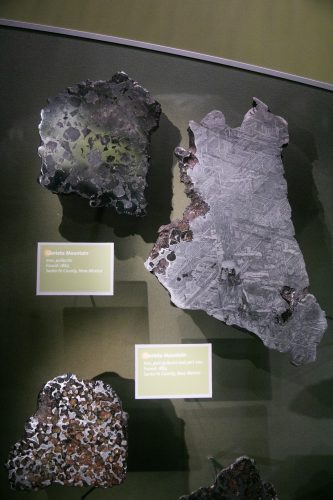A Stellar Space
Oscar Monnig’s passion for meteorites is on full display at a TCU gallery bearing his name.


A meteorite found in Kenya is among the almost 2,500 specimens in the Monnig Meteorite Gallery. Rhiannon Mayne oversees the gallery and adds to the collection, fulfilling Monnig’s aim of “both the science and the education,” she said. Photo by Rodger Mallison
A Stellar Space
Oscar Monnig’s passion for meteorites is on full display at a TCU gallery bearing his name.
In the dimly lit Monnig Meteorite Gallery, tucked inside TCU’s Sid Richardson Building, small spotlights shine on the specimens. Meteorites are made up of rock, iron or nickel; they typically come from comets, asteroids or meteoroids.
Oscar Monnig graduated from the University of Texas in 1925. He began collecting meteorites in the early 1930s when he moved home to Fort Worth, where he ran his family’s dry goods business. He used his network to add to his collection.
“He offered people $1 a pound for their samples, which in the Great Depression was a great price,” said Rhiannon Mayne, the Oscar and Juanita Monnig Endowed Chair of Meteoritics and Planetary Science. “He had his traveling salesmen give brochures out describing how Monnig was interested in purchasing weird rocks.”

The artifacts on display at the Monnig Meteorite Gallery were donated or purchased by Oscar Monnig. Photo by Rodger Mallison
Monnig gained an ally and friend when he met Arthur Ehlmann, professor of geology at TCU from 1958 to 1993. “People would bring [Monnig] rocks, thinking they were meteorites,” Mayne said. “Monnig approached Ehlmann because he needed someone to tell him what kind of rock it was if it wasn’t a meteorite.”
Monnig donated his collection to the university. Upon his death in 1999, he left significant funding to the geology department to maintain the collection. Ehlmann continued to look after the collection until his death in 2017.
The Monnig Meteorite Gallery opened Feb. 1, 2003, with just shy of 400 meteorites. In its early days, about 1,000 people came to visit each year; most were home-schoolers and students from private schools. Nona Batiste, gallery educator from 2012 to 2021, increased those numbers by bringing in public school classes and doing extensive outreach.
Mayne adds to the scientific collection every year with purchases and donated specimens. Phil and Ann Mani, through Radiant Point Ltd., donated a meteorite believed to be from Mars and another that, Mayne said, might be the oldest magmatic rock found in the solar system. Today, only 5 percent of the collection’s nearly 2,500 meteorites are on display.
A gallery update in 2019 brought new digital elements, refreshed exhibits and a renovated cinema. In 2022, Mayne worked with a group of computer science majors who created an app using an array of technology — Bluetooth beacons, language translation, text-to-speech and user interface customization — to help all visitors better experience the gallery.
“Oscar wanted both the science and the education,” Mayne said, “so I try and honor what Oscar wanted and do both.”

The Monnig Meteorite Gallery opened Feb. 1, 2003, and hosts many school field trips each year. Photo by Rodger Mallison

Your comments are welcome
Comments
Related reading:
Campus News: Alma Matters, Research + Discovery
Rhiannon Mayne Collects Meteorites
TCU’s resident meteorite expert explores clues about Earth’s beginnings.
Campus News: Alma Matters
Object Lesson: TCU’s Mace
The symbol of strength includes elements of brass, bronze, amethystine quartz and salvaged wood.
Alumni
Lunar exploration . . . Walter Kiefer ’84
For scientist Walter Kiefer ‘84, the mysteries of the moon are more than poetic.